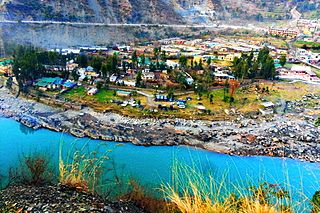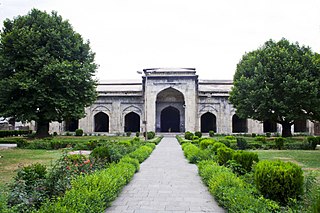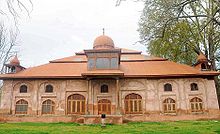
Srinagar is a city in Indian-administered Jammu and Kashmir in the disputed Kashmir region. It is the largest city and summer capital of Jammu and Kashmir, which is an Indian-administered union territory. It lies in the Kashmir Valley along the banks of the Jhelum River, and the shores of Dal and Anchar lakes, between the Hari Parbat and Shankaracharya hills. The city is known for its natural environment, various gardens, waterfronts and houseboats. It is also known for traditional Kashmiri handicrafts like the Kashmir shawl, papier-mâché, wood carving, carpet weaving, and jewel making, as well as for dried fruits. It is the second-largest metropolitan area in the Himalayas.

The Srinagar District is an administrative district of Indian-administered Jammu and Kashmir in the disputed Kashmir region. It is one of the 20 districts of Jammu and Kashmir. Situated in the centre of the Kashmir Valley, it is the second-most populous district of the union territory after Jammu District as per the 2011 national census, and is home to the summer capital city of Srinagar. Likewise, the city of Srinagar also serves as the Srinagar District's headquarters.
Nowhatta, known as Navyut in Kashmiri, is a town of historical importance situated at a distance of 5 km from Lal Chowk, Srinagar in Jammu and Kashmir, India. Nowhatta is famous because of Historical Mosque known as Jamia Masjid. Nowhatta area has eighteen sub-communities Mohalla. The place is also notable for high rate of stone pelting incidents in Kashmir. Each week after Friday prayers, people stage their protest against Indian rule which most of the times results in stone pelting incidents in the area.

Indo-Islamic architecture is the architecture of the Indian subcontinent produced by and for Islamic patrons and purposes. Despite an initial Arab presence in Sindh, the development of Indo-Islamic architecture began in earnest with the establishment of Delhi as the capital of the Ghurid dynasty in 1193. Succeeding the Ghurids was the Delhi Sultanate, a series of Central Asian dynasties that consolidated much of North India, and later the Mughal Empire by the 15th century. Both of these dynasties introduced Islamic architecture and art styles from West Asia into the Indian subcontinent.

The Shah Mir dynasty was a dynasty that ruled the region of Kashmir in the Indian subcontinent. The dynasty is named after its founder, Shah Mir.

Jama Masjid is a mosque in Srinagar, Jammu and Kashmir, India. Situated at Nowhatta in the Old City, the Mosque was commissioned by Sultan Sikandar in 1394 CE and completed in 1402 CE, at the behest of Mir Mohammad Hamadani, son of Mir Sayyid Ali Hamadani, and is regarded as one of the most important mosques in Kashmir. The mosque is located downtown, a central zone in the religio-political life in Srinagar. Thronged by Muslims every Friday, it is a prime tourist attractions of Srinagar.

Hari Parbat, also called Koh-i-Maran, is a hill overlooking Srinagar, the largest city and the capital of Jammu and Kashmir, India. It is the site of the Hari Parbat fort, built by the Durrani Empire, and of a Hindu temple, mosques, and gurdwara.

Ramban is a town in Ramban district of Jammu and Kashmir, India, which is the district headquarters of Ramban district. It lies on the banks of the Chenab river in Chenab Valley on the National Highway-1A at about 120 km from Jammu and about 130 km from Srinagar, making it almost the central point on the Jammu-Srinagar National Highway.
Shangus is an assembly constituency and a tehsil in Anantnag district of the Indian union territory of Jammu and Kashmir. It is the biggest village in Anantnag District in terms of Population and area. Jamia Masjid Shangus popular as Masjid e Mukaram is the 2nd largest Majid in J&K after Jamia Masjid, Srinagar and was built by Khawaja Mohd Maqbool khan led Auqaf in 1963.

Madin Sahib (Madeen Sahab or Madin Saeb) is an old mosque located near Nowshohar, Srinagar, in Kashmir. The other neighborhoods close to it would be Bagh-e-Ali Mardan Khan and Saz Ghar Poor. Madin Sahib Masjid was built by Sultan Zain-ul-Abideen (Budshah) in 1448. He named it after his teacher Syed Mohammad Madani, who is also buried to the left of the Masjid. Syed Mohammad Madani became Madin Saeb for Kashmiris.
Syed Madani came from Madeenah to India with Timur in 1398. He was sent to Kashmir as Timur's envoy to Sultan Sikander. Madin Sahib liked Kashmir so much that he decided to stay. He initially stayed in Rainawari after becoming a disciple of Syed Mohammad Hamadani. He later on moved close to Badshah's Capital Nowshahar, where Budshah built him the Khankhah. He died on 11 Rajab 849. Khwaja Baha-Ud-Din (Ganj-Bakhash) lead his funeral prayer. The tile work at Madin Saeb is considered one of the unique examples of this art and it is not seen anywhere else in Kashmir or Indian sub-continent for that matter.
Nadihal is a village located in the north of the Indian union territory of Jammu and Kashmir. It is just 4 km away from Bandipora town, and 51 km away from Srinagar. It the largest village in Bandipora district. There are many small villages around it. It is a prosperous and modern village with a population of 5167. Nadihal is inhabited by only Muslims. In this village, there are two government middle schools, one higher secondary school, and two high schools. Besides Government-run schools, there are a few private schools and a Public Institute Popularly known as Radiant Public Secondary School as well in this village. The level of education in Nadihal is moderate but has significantly increased in recent times.
Downtown, popularly known as Shahar-e-Khaas, is the largest and the most densely populated area of the city of Srinagar in the union territory of Jammu and Kashmir, India. The area is mostly located on the banks of Jhelum river about five km (3.1 mi) from city center. The area is considered as the core point in the city as the first inhabitants of the Srinagar lived there. In general, the whole area to the north of city centre Lal Chowk is considered a part of downtown although some areas hold high significance. The Jamia Masjid, Srinagar and many other shrines are located here, which makes it the central spiritual, religious, political and moral center of whole Kashmir.
Karan Nagar is the notified area and the town in the city of Srinagar in the Indian administered union territory of Jammu and Kashmir. A portion of Karan Nagar in the name of Deewan Bagh was the first declared civil colony in 1942 by the former princely state government of Jammu and Kashmir. It is a posh locality of Srinagar city. The famous SMHS hospital and Government Medical College is located here. It is located about 2 km (1.2 mi) from the commercial center of Kashmir, Lal Chowk.

Khanqah-e-Moula, also known as Shah-e-Hamadan Masjid and Khanqah, is a mosque located in the Old City of Srinagar in Jammu and Kashmir, India. Situated on the right bank of the river Jhelum between the Fateh Kadal and Zaina Kadal bridges, it was first built in 1395 CE, commissioned by Sultan Sikendar in memory of Mir Sayyid Ali Hamadani. It is held to be the first Khanqah—mosques associated with specific saints—in the Kashmir valley. It is one of the best examples of Kashmiri wooden architecture, and is decorated with papier mache.

Khushal Sar is a lake located in Srinagar, Jammu and Kashmir, India. It is in a highly deteriorated condition and has been encroached upon at many places with illegal construction and landfilling. The lake once stretched from Zoonimar up to the Aali Masjid but now it is considerably reduced. It is connected to the Anchar lake via a small channel. Another smaller lake, known as Gilsar, is connected to the Khushal Sar via a narrow strait, which is spanned by a bridge known as Gil Kadal. The Gilsar lake is in turn connected to the Nigeen lake via the Nallah Amir Khan. Until the 1970s, the Mar Canal drained into this lake providing navigability up to Ganderbal via the Anchar lake. After the filling up of the Mar Canal, the condition of the lake deteriorated further.

Pathar Mosque, known locally as Naev Masheed, is a Mughal era stone mosque located in the old city of Srinagar, in the Indian state of Jammu and Kashmir. It is located on the left bank of the River Jhelum, just opposite the shrine of Khanqah-e-Moula. It was built by Mughal Empress Noor Jehan, the wife of emperor Jehangir, in 1623, for Shi’a Muslim Population. Soon after its construction, the mosque was declared unfit for prayers and was used instead for non-religious purposes. The structure was reconverted into a mosque in the early 1930s. The mosque has some distinct features that separate it from the rest of the mosques in the Kashmir Valley. Unlike other mosques, it does not have the traditional pyramidal roof. Furthermore, the mosque has nine mehraabs (arches), with the central one being larger than the others.

The 2017 Nowhatta mob lynching, was the lynch mob murder and mutilation of an on-duty undercover Indian Jammu and Kashmir Police officer Muhammad Ayub Pandith, on the Muslim holy night of Laylat al-Qadr on Thursday 22 June 2017 by a mob in Nowhatta after a crowd shouted slogans in favor of Pakistan as well as al-Qaida jihadist Zakir Musa. Sajjad Ahmad Gilkar, a Hizbul Mujahideen militant, had played a key role in the lynching according to the state police.

Akhund Mullah Shah Masjid or Akhoon Mullah Masjid or Dara Shikoh Masjid, known as Mala Shah Mashid in Kashmiri, is a mosque built by Dara Shikoh in 1649 for his spiritual mentor. Located in Srinagar, Jammu and Kashmir, India, it is a mosque inside a mosque. The prime sanctuary is entirely separated from the main building through a courtyard that surrounds it. There is a stone lotus that crowns the podium of the mosque.

Patushay, also known as Potshai, was an autonomous village located in the Bandipora district of Jammu and Kashmir, India. Eventually, it was merged with Qazipora to form a new village called Qazipora Patushi. Patushay is located 4 km from Bandipora town and 59 km from Srinagar. The name Patushay is derived from the word Poàt, meaning Old, and Shay, meaning Place of history.
Saleem Beg is an Indian art conservator, historian and columnist. He is working to conserve / preserve the artworks, architecture, archaeology, besides museum collections mainly connected to Kashmir heritage. He prepared the research dossier of seven crafts include papier-mache, pashmina, Khatamband, Woodwork, Pinjrakari (latticework), Ari and Metal craft which placed the Srinagar city of Jammu and Kashmir in the list of UNESCO creative cities network for 2021, in the field of craft and folk art.
















